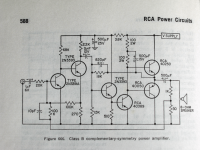Found a bunch of RCA 40250 power NPNs in cute TO66 package.
These hometaxials have low fT ~1MHz, any use for audio other than PSU?
Headamp maybe? I haven't found any amp schematics using these.
These hometaxials have low fT ~1MHz, any use for audio other than PSU?
Headamp maybe? I haven't found any amp schematics using these.
It IS a driver, not just sized like one. Yes, it will make a small output - so does any driver. For a 5-10 watt or so amplifier.
The only use they would find is if you were playing with vintage topologies - for its own sake. Some of us do, I guess because it’s as close to time travel as we’re ever really going to get. Mr. Spock playing with stone knives and bear skins comes to mind every time. I suppose it’s possible to combine old and new - like driving a pair with some $40 1GHz fT CFA front end, but in the end it’s only a small set of hometaxial outputs with limited current capacity… in QC or SE-A. For the investment in a high speed front end you’ll want more.
Headphones? Sure. What that calls for is a small amplifier. Again, only vintage topologies need apply.
The only use they would find is if you were playing with vintage topologies - for its own sake. Some of us do, I guess because it’s as close to time travel as we’re ever really going to get. Mr. Spock playing with stone knives and bear skins comes to mind every time. I suppose it’s possible to combine old and new - like driving a pair with some $40 1GHz fT CFA front end, but in the end it’s only a small set of hometaxial outputs with limited current capacity… in QC or SE-A. For the investment in a high speed front end you’ll want more.
Headphones? Sure. What that calls for is a small amplifier. Again, only vintage topologies need apply.
Actually a good gambit would be to apply modern thinking to working around the limitations of an old device. If they're too slow to permit stable feedback, and not too linear at low Ic, a class A output at 1-2 watts without loop feedback might put the best face on them. The front end should use vintage devices as well, and given their own compensations, to make the concept whole.
The hard to mount package, with 4 precisely located holes, means I would use it only as an output transistor replacing a similar part. My Sony TC250 tape recorder had some TO66 transistors. The low Ft means it would sound like **** driving a TO3 output pair. I had TIP31c/32c with 6 mhz ft driving MJ15003 in my apex ax6 board. Highs were missing compared to 2n5320/5322 on the opposite channel which has 50 mhz ft.
The 40310 is very similar, and RCA had published an app-note for a plain-vanilla 10W amplifier. It sounded OK at the time (>50 yrs ago).
I probably have a schematic somewhere, if you are interested.
Another possibility would be a simplified Circlophone: the circuit is very tolerant and could accommodate them.
It would be inverted, because drivers wouldn't be necessary, and it would sound good
I probably have a schematic somewhere, if you are interested.
Another possibility would be a simplified Circlophone: the circuit is very tolerant and could accommodate them.
It would be inverted, because drivers wouldn't be necessary, and it would sound good
Well found: that's exactly the one. By today's standards, it's lacking everything, but it did work quite well, and when I retired it for an upgrade, I passed it to my cousins, and they too enjoyed it for a few more years
Jacques - You have found a historically significant transistor.
From the "RCA Solid-State Power Circuits Designer's Handbook" (1971), here is a class B amplifier with the crossover notch "fixed" by negative feedback. This is the amplifier that gave early solid-state a bad reputation.
It is a do-not-build. 😉
Ed
From the "RCA Solid-State Power Circuits Designer's Handbook" (1971), here is a class B amplifier with the crossover notch "fixed" by negative feedback. This is the amplifier that gave early solid-state a bad reputation.
It is a do-not-build. 😉
Ed
Attachments
Interesting: I never noticed that one.
The µA709 opamp is supposed to have the same output configuration, and H. Schreiber, a well-known French author also advocated the strategy, but with an opamp as a gain-block, which certainly ruined the concept, because of the seventies opamps limitations regarding bandwidth, SR, etc.
That said, I have in my prototypes (junk in fact) box, an amplifier (discrete obviously) that couldn't betray its hard and pure class B nature if investigated as a black-box.
It doesn't even use ultra-fast transistors or anything fancy, and you'd be hard-pressed to find defects in the time-domain waveforms.
Although it ticked all the boxes, I never pursued it further (probably a wise decision).
I could try to unearth it, if someone is interested
The µA709 opamp is supposed to have the same output configuration, and H. Schreiber, a well-known French author also advocated the strategy, but with an opamp as a gain-block, which certainly ruined the concept, because of the seventies opamps limitations regarding bandwidth, SR, etc.
That said, I have in my prototypes (junk in fact) box, an amplifier (discrete obviously) that couldn't betray its hard and pure class B nature if investigated as a black-box.
It doesn't even use ultra-fast transistors or anything fancy, and you'd be hard-pressed to find defects in the time-domain waveforms.
Although it ticked all the boxes, I never pursued it further (probably a wise decision).
I could try to unearth it, if someone is interested
The RCA book says 1% THD... but it has every odd harmonic. I suspect this amplifier was used along with old speakers that lacked tweeters.
Ed
Ed
- Home
- Amplifiers
- Solid State
- 40250 RCA
